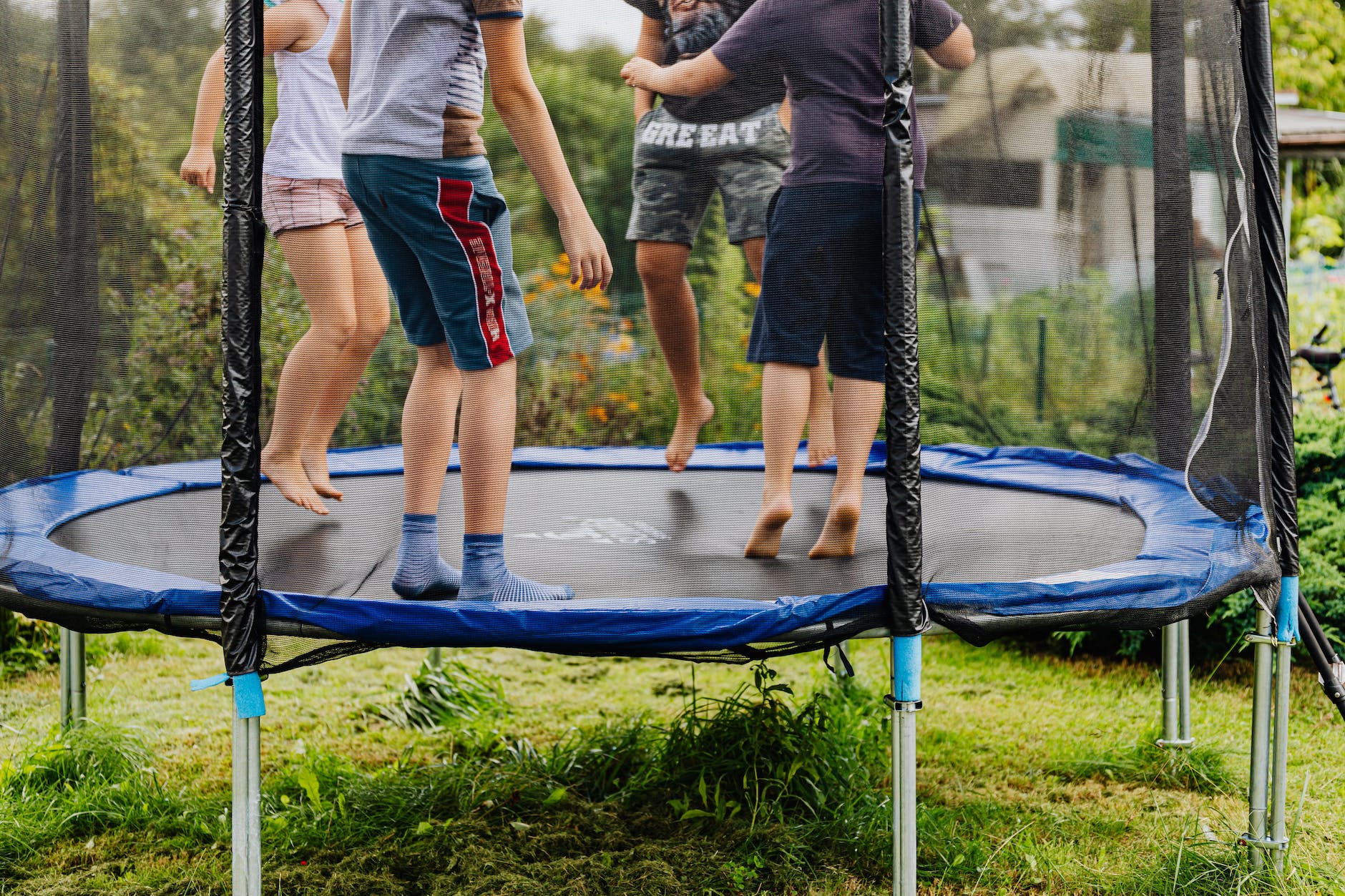
Health Benefits of Exercising on a Trampoline
Rebounding, also notable as trampolining, can be an attractive and effective way to grow overall health and fitness. Although trampolines may be associated with childhood fun, they also provide an effective low-impact full-body workout. Aside from its versatility, it is also suitable for people of all ages and fitness levels.
Rebounding has been found to provide many health advantages including cardiovascular fitness enhancement and muscle strengthening increases. Here, we explore these top health advantages as well as how this fun yet effective form of exercise contributes towards creating an active lifestyle!
Improved Cardiovascular Health
When it comes to improving cardiovascular health, trampolining can be an invaluable asset. Jumping on a trampoline can increase heart rate and oxygen uptake – two essential measures of cardiovascular fitness.
Trampolining provides a low-impact way of getting the heart beating. It is an excellent option for people with joint pain or injuries that limit them from engaging in higher-impact exercises.
A small fitness trampoline can be utilized in multiple ways to boost cardiovascular fitness.
Bouncing at a steady pace for a set amount of time is an effective way to raise the heart rate and build aerobic fitness. Also, switching between high-intensity jumping bursts and lower-intensity rest periods may also prove effective at increasing cardio fitness.
Increased Lymphatic Flow
Fitness trampolines can also help increase lymphatic flow in the body. Lymphatic systems are responsible for eliminating waste products, toxins, and other substances from our bodies. Unlike the circulatory system, the lymphatic system does not have a pump to move lymphatic fluid through the body. Instead, it relies on the movement of muscles to help circulate the fluid.
Trampolining offers not only immune-enhancing effects but can also be an excellent low-impact way to promote circulatory health and cardiovascular well-being. Trampolining’s rhythmic bouncing motion can increase blood flow which may help lower risk factors associated with cardiovascular disease.
As with any exercise program, it is advised to consult a healthcare professional first before beginning trampoline exercises. Furthermore, selecting a high-quality trampoline with safety precautions may prove invaluable for increasing lymphatic flow and supporting overall health.
Improved Balance and Coordination
Maintaining good physical health as we age requires improving balance and coordination. A small fitness trampoline can be an invaluable asset in this regard. As you bounce on a trampoline, your body must constantly adapt to maintain balance and stability.
Over time, regular trampoline exercise can help develop your balance and coordination. Getting a small fitness trampoline can help individuals who are recovering from injuries or have conditions that disrupt their balance. Improving your balance and coordination entails a better quality of life.
Increased Bone Density
Trampolining is a weight-bearing exercise, which means it can help to increase bone density and prevent osteoporosis. This is especially important for older adults at risk for bone loss. Weight-bearing exercise actions, where your body’s weight is supported by resistance, have been proven to be particularly beneficial for growing bone density.
Examples include running, walking, and dancing. Jumping on a fitness trampoline can also be an effective exercise that is weight-bearing. A trampoline’s jump places stress on the bones in your hips, legs, and spine, creating stress that increases their density and strength over time. This prevents bone loss and reduces the risk of breaking.
Reduced Joint Impact
Small fitness trampolines offer an ideal low-impact exercise option for individuals seeking a low-stress workout. As opposed to running or jumping rope, trampolining puts less strain on joints, making it safer and more suitable for individuals experiencing joint pain or injuries.
As you bounce on a trampoline, the impact of each jump is absorbed by its mat rather than the joints. Helping reduce joint injuries and making trampolining an attractive choice for individuals with conditions like arthritis.
Research has demonstrated the effectiveness of trampoline exercise as an effective means of reducing joint impact. One study demonstrated how trampoline exercises led to lower joint impact forces when compared with running on a treadmill. It also produced lower peak ground reaction forces in the ankle, knee, and hip joints when compared with running.
Improved Mental Health
Trampolining is a fun and engaging activity that can help to reduce stress and improve mood. Regular exercise has been shown to release endorphins, which are feel-good chemicals that can boost mental health.
Exercise has long been recognized as an invaluable way of improving mental health, and trampolining can be an especially effective way of lifting mood and relieving stress.
A small fitness trampoline can be a great tool for improving mental health and supporting physical health.
Increased Muscle Strength
Small fitness trampolines, commonly referred to as rebounders, can be an enjoyable and effective way to increase muscle strength. Rebounding on one involves jumping, bouncing, and twisting for increased activation.
Rebounding can help to develop better balance and coordination for older adults, making it especially useful. To maximize muscle strength with a small fitness trampoline, it’s key to control the intensity and duration of workouts.
Starting out with simple jumps can gradually lead to more complex moves such as jumping jacks, twists, and high knees. Weights or resistance bands may add even further challenges and strengthen your muscles further.
Improved Flexibility
Rebounders (also known as mini fitness trampolines) can help improve flexibility by offering low-impact aerobic workouts targeting multiple muscle groups such as legs, core, and arms. Jumping on a rebounder helps lengthen and strengthen muscles for an increased range of motion and increased flexibility.
Rebounding on a mini fitness trampoline involves performing movements that require flexibility, such as jumping, bouncing, and twisting.These actions stretch and strengthen your muscles, tendons, and ligaments, which enhances overall flexibility and range of motion.
Support Pelvic Floor Health
Pelvic floor muscles supply assistance to pelvic organs such as the bladder, uterus, and rectum. Poor pelvic floor health and muscles may result in prolapse and other pelvic floor disorders.
Regular exercise on a small fitness trampoline can help strengthen pelvic floor muscles and enhance health, engaging more of their tone and strength. Trampolining regularly, can strengthen pelvic floor muscles while improving overall health.
One study demonstrated the efficacy of trampoline exercise for strengthening pelvic floor muscles and decreasing symptoms of urinary incontinence among women. Another research paper found improvements in pelvic floor muscle strength and overall quality of life among postmenopausal women after participating in trampoline exercises.
Enhanced Weight Loss
Trampolining can be an excellent way to burn calories and enhance weight loss efforts. Just a 30-minute trampoline exercise can burn 240 calories – making it an impressive exercise for anyone hoping to shed a few pounds.
Small fitness trampolines can be an invaluable aid to weight gain as part of an effective fitness idea. Bouncing back involves jumping on a trampoline for an engaging low-impact cardiovascular workout that burns calories while improving cardio fitness.
To enhance weight loss with a small fitness trampoline, it’s important to incorporate rebounding into a well-rounded fitness program that includes aerobic exercise. It’s also important to vary the intensity and duration of your rebounding workouts to keep challenging your body.
Final Comment
Overall, trampolining offers many health advantages ranging from improved cardiovascular health to weight loss efforts. As with any exercise program, starting slowly and increasing intensity gradually is key to avoiding injuries.






